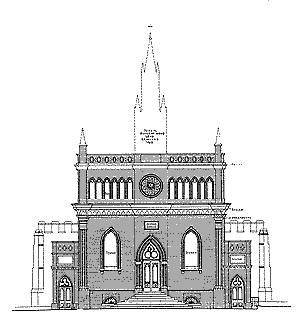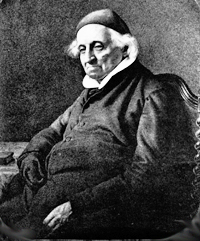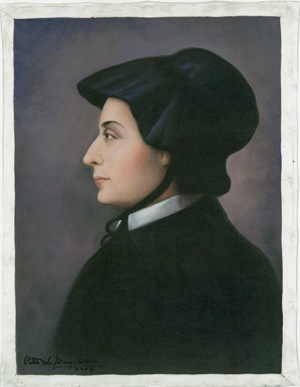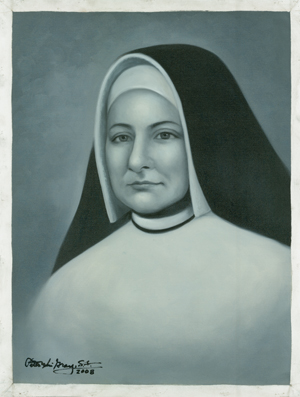
Historic Seminary Chapel
Introduction
In 2008, the Historic Seminary Chapel celebrated its 200th Anniversary of continued use as a worship site.
Construction on the seminary chapel began in 1806 and took almost two years to be completed, with the dedication by Bishop John Carroll on the Feast of Corpus Christi 1808. For well over one and a half centuries, this first neo-gothic structure in the United States served the needs of St. Mary’s Seminary and the local surrounding neighborhood.
The upper chapel served the needs of the seminary community from 1808 until 1969, when the seminary program was relocated to the campus of St. Mary’s Seminary & University in the Roland Park section of Baltimore City.
The lower chapel (or “Chapelle Basse,” as it was commonly known) served the needs of the laity in the area.
Maximilian Godefroy
The French-born architect Maximilian Godefroy (1765-c.1840) designed St. Mary’s Chapel and probably the Mother Seton House.
Godefroy was a friend of Benjamin Latrobe, who is often referred to as the Father of American Architecture. Godefroy spent 14 years in the United States (1805-1819) after being exiled from France by Napoleon for his political activities.
Godefroy is credited with introducing into America many distinct styles and elements from French architectural developments of the late 18th and early 19th centuries.
Other Baltimore landmarks designed by Maximilian Godefroy are the Battle Monument in downtown Baltimore and the Unitarian Church located only a few blocks from St. Mary’s Chapel.
Upper Chapel
As noted above, the upper chapel was designed to serve the spiritual and worship needs of the seminary community. The initial design featured choir stalls facing each other in the nave of the chapel, a common design used in monasteries and seminaries that was more conducive for the antiphonal recitation of the hours of the Divine Office. Many of the Sulpician Fathers who called this seminary chapel their spiritual home went on to become bishops of early dioceses across the United States: Simon Gabriel Bruté de Remur, first bishop of Vencennes (now Indianapolis); John Joseph Chanche, first bishop of Mississippi (then Natchez and now the Diocese of Jackson); Louis W. DuBourg, P.S.S., founder of St. Mary’s College and later first bishop of New Orleans.
Benedict Joseph Flaget was first sent to Illinois country, but in 1795 Bishop Carroll made him vice-president of Georgetown College. In 1801, he became a member of the faculty of St. Mary’s.
On April 8, 1808, Pope Pius VII subdivided the premier see of Baltimore by constituting the Dioceses of Boston, New York, Philadelphia, and Bardstown. To head the latter see, the first in inland America, the Holy See named Benedict Joseph Flaget. This “First Bishop of the West” arrived in Kentucky in 1811.
Late in 1841, Bishop Flaget would move the seat of the diocese from Bardstown to the city of Louisville.
In 1792, St. Mary’s received a new student in the person of Stephen Badin who, a year after his arrival to Baltimore, was to have the distinction of being the first Catholic priest ordained in the United States. In 1795 Fr. Badin went to Kentucky and except for a visit to France for the years 1820-1828, he remained in the West during the remainder of his life.
Others who attended the seminary and were ordained from St. Mary’s Seminary on Paca Street include Fr. Demetrius Gallitzin, also known as “Prince Gallitzin.” He was Russian royalty who came to the U.S. and was the first priest to complete his entire seminary program in the U.S.; Blessed Fr. Michael J. McGivney, ordained a priest of the Diocese of Harford (1877) and founder of the Knights of Columbus; Fr. Thomas Price, ordained in 1886 and co-founder of the Catholic Foreign Mission Society of America (Maryknoll Fathers and Brothers); and many others too numerous to note individually.

Lower Chapel or “Chapelle Basse”
The area surrounding the historic site is now known as the Seton Hill neighborhood of Baltimore City. Two hundred years ago the area that encompassed the seminary and St. Mary’s College on North Paca Street was quite different. In the early 1800s the neighborhood was known as Baltimore’s French Quarter. With individuals from Canada, Haiti, and other French-speaking parts of the world, it’s no wonder the French Sulpician Fathers felt at ease in this section of Baltimore.
The Lower Chapel became the worship site for the neighborhood. Sr. Reginald Gerdes, OSP, historical researcher for the Oblate Sisters of Providence, notes that the site became the birthplace for the first African-American Catholic faith community. Sr. Reginald’s community, the Oblate Sisters of Providence, trace their roots to the Lower Chapel and the work of Mary Elizabeth Lange, an immigrant from Cuba, and Sulpician Father James Hector Joubert, who are co-founders of the Oblate Sisters of Providence.
It was also in the Lower Chapel that Elizabeth Bayley Seton pronounced private vows before Bishop John Carroll. It was Bishop Carroll that gave her the title “Mother,” both for the community she intended to found and reflecting her experience as wife, widow, and mother. Mother Seton worshipped in the Upper Chapel for much of her time at Paca Street, as the lower chapel did not open until the spring of 1808.
Another woman of renown who knew the chapel as her spiritual home was Sr. Theresa Maxis Duchemin. Born of a Haitian mother and a British father, she worshiped at St. Mary’s Chapel. Under the guidance of Sulpician Father Joubert, she was one of the founding members of the Oblate Sisters of Providence and later served as Superior General. At the invitation of Belgian Redemptorist Father Louis Florent Gillet, Mother Theresa Maxis Duchemin traveled to Detroit to work with the French-speaking Catholics in that area. It was in 1845 that she established the Sisters, Servants of the Immaculate Heart of Mary (IHM) of Monroe, Michigan. She went on to found IHM communities in Scranton and Philadelphia, Pennsylvania.















